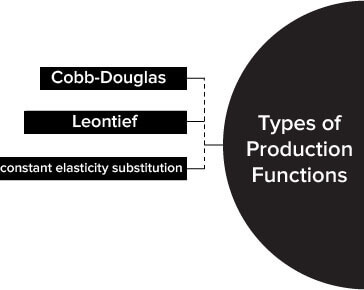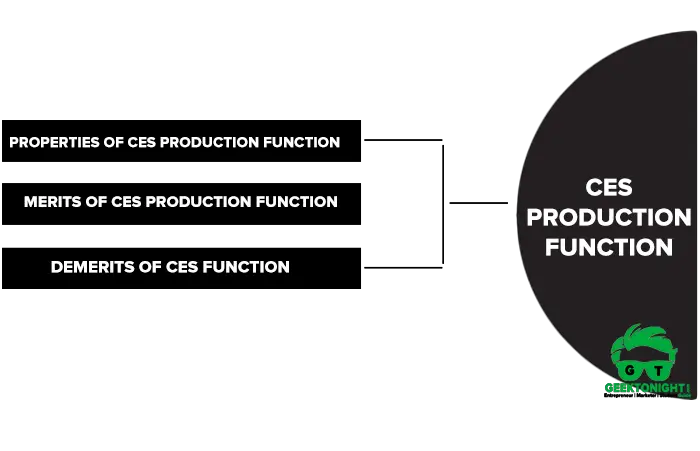3 Types of Production Functions are:

Table of Content
There are different types of production functions that can be classified according to the degree of substitution of one input by the other.
Figure illustrates different types of production functions:

Cobb Douglas Production Function
The Cobb Douglas production function, given by American economists, Charles W. Cobb and Paul. H Douglas, studies the relation between the input and the output.
The cobb douglas production function is that type of production function wherein an input can be substituted by others to a limited extent.
For example, capital and labour can be used as a substitute of each other, however to a limited extent only. Cobb Douglas production function can be expressed as follows:
Q = AKa Lb
Where,
A = positive constant
a and b = positive fractions
b = 1–a
Another way of expressing Cobb- Douglas production function is:
Q = AKa L1-a
Let us take up an example to understand the calculations involved in the cobb-Douglas function.
Assume A = 40, a = 0.3 and b= 0.7 , K = 3 and L = 5
Therefore,
Q = 40 (3)0.3 (5)0.7
log Q = log 40 + 0.3 log 3 + 0.7 log 5
log Q = 1.6020 + (0.3 X 0.4771) + (0.7 X 0.6989)
log Q = 1.6020 + 0.1431 + 0.4892
log Q = 2.2343
Now, we will take the antilog of the above to get the value of Q. antilog log Q = antilog 2.2343
Q = 171.5141
Cobb Douglas Production Function Properties
The main attributes of the Cobb Douglas production function are discussed as follows:
- It enables the conversion of the algebraic form into log linear form, represented as follows:
log Q = log A + a log K + b log L
This production function has been estimated with the help of linear regression analysis. - It acts as a homogeneous production function, whose degree can be calculated by the value obtained after adding values of a and b. If the resultant value of a+b is 1, it implies that the degree of homogeneity is 1 and indicates the constant returns to scale.
- It makes use of parameters a and b, which signifies the elasticity coefficients of output for inputs, labour and capital, respectively. Output elasticity coefficient is the change in output that occurs due to adjustment in capital while keeping labour at constant.
- It depicts the non-existence of production at zero cost.
ALso Read: Production in Economics
Leontief Production Function
Leontief production function, evolved by W. Wassily Leontif, uses fixed proportion of inputs having no substitutability between them.
It implies that if the input-output ratio is independent of the scale of production, there is existence of Leontief production function. It assumes strict complementarity of factors of production. Leontief production function is also called as fixed proportion production function.
This production function can be expressed as follows:
q= min (z1/a, z2/b)
where, q = quantity of output produced
z1 = utilised quantity of input 1
z2 = utilised quantity of input 2
a and b = constants
Minimum implies that the total output depends upon the smaller of the two ratios.
The coefficients a and b are the fixed input requirements for producing a single unit of output. It means that if we want to produce q units of output, we need aq units of capital (z1) and bq units of labour (z2).
Or we can mathematically state that, z1 = aq represents the capital requirements and z2 = aq represents the labour requirements.
Therefore, z1 / z1 = a/b. that is, there is a particular fixed proportion of capital and labour required to produce output. That is if we increase one of the factors without increasing the other factor proportionally, then there will be no increase in output.
For example, suppose the Leontief production functions for goods X is
X = min [ 3 Lx , 7 Kx]
This implies that for producing a single unit of X, a minimum of 1/3 unit of labour and 1/7 unit of capital would be required.
X = min [ Lx / (1/3) , Kx / (1/7)]
In this case, the values 1/3 and 1/7 depict labour activities and therefore, are activity coefficients as they depict labour activities.
Now, say 1/3 of a day’s work is required to produce 1 unit of X, and the activity required of capital 1/7 of a day’s work to produce 1 unit of X.
With Lx = 5 and Kx = 3, X = min [ 15, 21] = 15 units of X.
Therefore, with 15 units of X ; Lx = 5 and Kx = 2, you get X = min [15, 14] = 14 units of X.
The logical capital-labor ratio in the X industry to choose will be Kx / Lx = 3/5 = 0.6.
Also Read: Production Possibility Curve
CES Production Function
CES stands for constant elasticity substitution. CES production function displays a constant change produced in the output due to change in input of production.

It is expressed as:
Q = A [aK–β + (1–a) L–β]–1/β
CES has the homogeneity degree of 1 that implies that output would be increased with the increase in inputs. For example, labour and capital has increased by constant factor m.
Q’ = A [a (mK)–β + (1–a) (mL)–β]–1/β
Q’ = A [m–β {aK–β + (1–a) L– β}]–1/β
Q’ = (m–β) –1/β .A [aK–β + (1-a) L–β]-1/β
Because, Q = A [aK–β + (1-a) L–β]-1/β
Therefore, Q’ = mQ
This implies that CES production function is homogeneous with degree one.
For example, let us assume that the CES production function’s parameters are as follows:
A = 1.0
a = 0.3
b = 0.7
β = 0.18
s = 1/(1+β) = 1/(1+0.18) = 0.847
L = 50
K = 30
The CES production function will be formed as follows:
Q = A [aK–β + (1–a) L–β]–1/β
Q = 1.0 * .3 X (L0.18) + .7 X (K0.18)
Q = 1.0 * .3 X 500.18 + .7 X 300.18
Q = 1.0 * .3 X 1 + .7 X 1
Q = 1.0 * 1
Q = 1.0 / 11/.18
Q = 1
Properties of CES Production Function
The properties of CES function are as follows:
- The value of elasticity of substitution depends upon the value of a.
- The marginal products are positive and slope downwards.
Merits of CES Production Function
The merits of CES production are as follows:
- Covers a number of parameters, such as efficiency and substitutability
- Easy to estimate
- Free from unrealistic assumptions, such as fixed technology, etc.
Demerits of CES function
The demerits of CES production system are as follows:
- Fails to fit for manufacturing industries
- Cannot be generalised in case of n factors of production
- Fails to give correct economic implications
Also Read: What is Production Function
FAQ
3 Types of Production Functions
3 Types of Production Functions:
1. Cobb Douglas production function
2. Leontief Production Function
3. CES Production Function
Production function can be defined as a technological relationship between the physical inputs and physical output of the organisation.
Article Include:
Meaning of Production Function
Production Function Definition
Uses of Production Function
Assumptions of Production Function
Limitations of Production Function
Cobb-Douglas Production Function
Read Complete: Production function
In economics, Production is a process of transforming tangible and intangible inputs into goods or services.
Production Definition
Concept of Production
Importance of Production
Factors of Production
Read Complete: What is Production?
What is Production Possibility Curve?
In economics, the Production Possibility Curve provides an overview of the maximum output of a good that can be produced in an economy by using available resources with respect to quantities of other goods produced. It is also known as Production Possibility Frontier (PPF) or transformation curve.
Article Include:
Production Possibility Curve Definition
Production Possibility Curve Example
Uses of Production Possibility Curve
Read Complete: Production Possibility Curve
Business Economics Tutorial
(Click on Topic to Read)
Go On, Share article with Friends
Did we miss something in Business Economics Tutorial? Come on! Tell us what you think about our article on Types of Production Functions | Business Economics in the comments section.
Business Economics Tutorial
(Click on Topic to Read)











I have found this website to be a good fit resource point for students